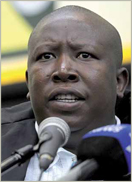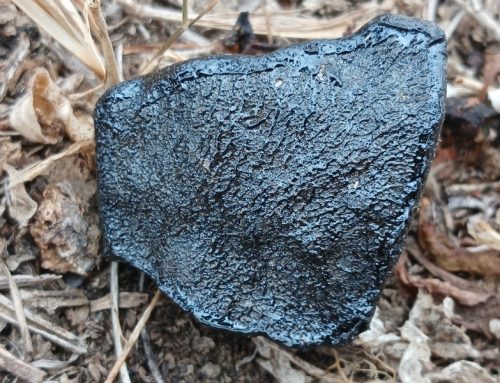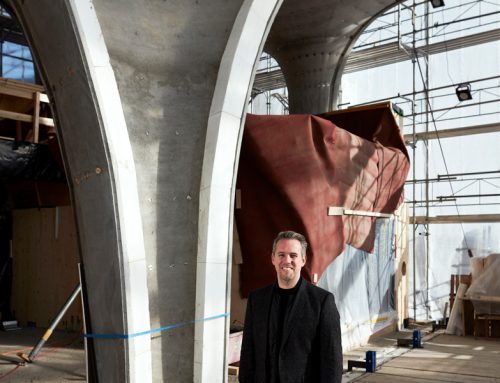 When Julius Malema and other stone-throwing politicians try to win votes by shouting about redistributing more white-owned commercial farms, they need to be taken in hand and shown that this is as logical as drinking brandy to get sober. – Andries Pienaar, 2010 South African Sheep Farmer of the Year.
When Julius Malema and other stone-throwing politicians try to win votes by shouting about redistributing more white-owned commercial farms, they need to be taken in hand and shown that this is as logical as drinking brandy to get sober. – Andries Pienaar, 2010 South African Sheep Farmer of the Year.
Seventeen years in South Africa’s democracy the overwhelming majority of land redistribution farming projects have dismally failed, which has serious implications for food security and the economy. As Agri Eastern Cape President, Ernest Pringle, puts it: “The whole Land Reform effort so far has been a politically driven disaster.”
Instead of focusing on the ever-increasing percentage of white commercial farms that need to be redistributed, the government needs to hang on to all the commercial farmers it still has, says Pringle. Since 1985 the number of commercial farmers in South Africa has dropped from 64 000 to 33 000 today.
“The government needs to shift its focus to support the farmers and enhance food security in the face of a rapidly expanding and increasingly urbanized population,” adds Pringle.
Commercial farming is not attractive to the majority of people because the returns are generally low and it is damn difficult to farm successfully. “Farming is no ‘get rich quick’ scheme; you are more likely to get poor quick, and then you get lumped with droughts over which you have no control and which can go on for years.”
The government also needs to encourage and mentor the young people of our country, black or white, who still want to farm. And there are young people who do, as is evident from the number of graduates from the surviving agricultural colleges, such as Grootfontein Agricultural Development Institute in Middelburg, Eastern Cape.
Equally important is that the Departments of Land Affairs and Land Reform urgently attend to the commercial farmers who are sitting with land claims and/or still waiting to be paid. “To not have resolved this situation is a horrible, absolute injustice to the farmers and the claimants, and it is a recipe for violence,” says Pringle.
He adds that as farmers, landowners and South African citizens we need to make ourselves heard. “Silence can too easily be regarded as consent, and we are then going to have to accept the consequences of this. Because if agriculture collapses, the economy collapses, such is its terrific multiplier effect across the land.”
Pringle believes we need to actively counter the voice of stone-throwing politicians whom he describes as “Capunists” (a hybrid of a Capitalist and a Communist). “They are normally very rich and can eloquently preach Das Kapital but have no understanding of farming and they ignore the realities of sustainable food production.”
We need to look no further than Zimbabwe for proof of this. Zimbabwe’s collapse can be traced to a single policy: its fast track land reform program, under which the Mugabe government, beginning in the year 2000, seized thousands of white-owned commercial farms, leading to a sharp drop in agricultural output and leaving everyone far worse off than before. Zimbabwe now has a 90% unemployment rate, out of control inflation and a collapsed economy where 50-billion Zimbabwe dollars doesn’t even buy you half a loaf of bread.
Yet this is the country that ANC Youth Leader Julius Malema visits as a model for South Africa when he has highly successful commercial farmers in his own country offering their knowledge, mentorship and skills to make a success of land reform.
Instead of being embraced, white commercial farmers are criticised, undermined and threatened. The time has come to halt this destructive trend and get on with the business of securing South Africa’s future.
ANDRIES ‘TOT’ PIENAAR
2010 SA Sheep Farmer of the Year
“I am not interested in politics because in most cases economic reality and political aspirations don’t gel. What I am interested in is systems that work and people who are committed to farming or agri business as I prefer to call it,” says Andries Pienaar whose family has been farming Merino sheep on the farm Klipplaatsfontein in the Northern Cape district of Colesberg for 123 years.
Pienaar’s agri business today comprises three Mega Merino stud farms (in Colesberg, Australia and New Zealand), an irrigation pasture farm in Luckhoff, Free State and an empowerment sheep farm in Hanover, which Pienaar together with his son Jacques and ten of their staff bought ten years ago.
“When the farm came up for sale, the grants offered to our staff as previously disadvantaged individuals only amounted to 50% of the payment required. Jacques and I then paid in the rest, we became 50/50 partners with our staff and today our empowerment farm is very successful,” says Pienaar who says the principle of ownership is essential. People simply don’t invest in the land when it is not their own.
The empowerment farm has since produced two SA Merino champions on the natural veld grazing show; it annually produces outstanding wool branded as ‘Charisma Fleece’, and it produces free-range lamb branded as ‘Shepherd’s Selection’ for Checkers. The empowerment farm is registered as Sheep Power Pty Ltd and it is in the top 5% of net profit in the district. Profits are divided according to shares.
“It is run as an agri business and not as a project,” says Pienaar. “The dictionary definition of project is a ‘scheme’ and too many land reform initiatives end up being nothing more than schemes.
“I have mentored my staff in business systems that work, with a focus on the five key performance disciplines in any agri business: marketing, finance, the product (i.e. the animal or the crop), the factory (i.e. the farm) and the people. You have to get 80% for each one of these for your business to flourish. And if you don’t know how to achieve this, then you get people who do know to help you,” says Andries who regularly runs empowerment agri business courses. Last year alone he trained 400 new farmers from all over South Africa and Lesotho.
“I make the courses very practical and I tell the new farmers that they must forget fighting about the past which I tell them is as useful as drinking brandy to get sober. All it does is waste time while the rest of the world gets ahead of us.”
Pienaar is the Chairperson of Pro Agri, a group of all the award winners of SA Farmer of the Year for the past 35 years. They have offered their skills and support to the Minister of Agriculture who has said she would like their help.
“What we need to do is put race and ethnicity aside, and pool our collective skills and brainpower to work together for South Africa,” he says. “Our motto is ‘God is our Source of Supply’ and ‘Discipline Creates Freedom’, and our mission is ‘to make South Africa number one in the world of agri business’.”
Hopefully the Minister actively secures their help without delay.
GERDIE LANDMAN
Leading South African dairy farmer and Pro Agri member
“In every district in this country there are top notch, highly experienced, successful farmers who want to help empower new farmers, including their staff, but the state needs to work with us,” says Gerdie Landman, leading South African dairy farmer from the Cookhouse/Fish River Valley and founder, owner and manager of Mooimelk Koeihotel which produces 15 million litres of milk a year.
Several years ago Landman sent a proposal and business plan to Land Affairs motivating them to purchase the farm next to his, which would then be sold to- and developed by his staff under his mentorship.
Land Affairs’ response was that they do not buy irrigation land because it is too expensive. This is not true because they are buying plenty of irrigation land in the selfsame Fish River Valley for a sugar beet scheme, which is far from proven as an economically viable form of agriculture.
Farm staff with farming experience who are assisted by or partner with commercial farmers are the ideal candidates to be offered the opportunity to develop their own farms.
“We don’t need to reinvent the wheel. There are excellent models of farmer development and land reform in South Africa that are highly appropriate to the land situation today,” says Landman. “I see great potential for farming once the powers that be recognise that it does not work to simply hand over land to people whom you call ‘emerging farmers’.
“New farmers need to be put into projects; they need support, structure and financial responsibility in order to rise to the many challenges of ownership of a farm. This is the only way to nurture people who really want to farm. Otherwise it is as nonsensical as putting someone behind the wheel of car who has never driven and wondering why they crash.”
Landman himself was part of a new farmer project as a young man without means. In 1983 the government launched a dairy-farming project where 19 farmers under the age of 35 were selected out of 2000 applicants to purchase 19 state-owned pieces of land in the Tsitsikamma region, 200 hectares each. Amongst the successful applicants, some had been farm foremen or managers and one was an agricultural extension officer.
“The land cost R200 000 for the 200 hectares but it was completely unfarmed. It was just a piece of bushveld, it had no infrastructure, no fences, no house, nothing,” Landman explains. Through Landbou Krediet en Grond Besit the successful applicants were offered a fixed interest rate of 8% at a time when the general interest rate was between 18% and 24%.
The success of the project was measured after ten years. Eighteen of the 19 made a success of farming in the Tsitsikamma. Most were milking 500 or more cows on their 200-hectare farms after ten years; the rest established themselves as successful sheep and beef farmers.
Clearly the project was a success. And it was a success despite subsequent complications, notably that the nineteen farms were reclaimed as part of the post 1994 land restitution process. “I lost my farm,” says Landman, “but I am a farmer, that is what I love and do best and I continued to farm my Tsitsikamma farm for a further fifteen years, renting the land from the successful land claimants, until I bought my current farm in the Fish River Valley.
“It must be stressed that the government paid market related prices for our Tsitsikamma farms and the process of payment on registration was properly and timeously executed. There can be no other way,” he adds.
Time restrictions need to be placed on restitution claims. Otherwise the government is infringing on property rights, which have to be market driven. Property rights constitute one of the cornerstones of good rule of law. If we fall victim to the collapse of property rights, we fall victim to the collapse of our economy.
WILLEM SYMINGTON
Northern Cape sheep farmer and Agri Northern Cape member
“The government owns thousands of hectares of commonage outside each rural town that can be effectively used to build up new farmers if the municipalities are willing to support this,” says Willem Symington, a successful Dorper sheep farmer from Williston.
In his part of the world known as the Karoo Highlands for example, Williston’s commonage is 6000 hectares, Sutherland’s is 3000 hectares and Fraserburg’s is over 8000 hectares.
Symington developed a model of small-scale farmer development that could work throughout the country.
“Three years ago I started a partnership with a new farmer named Isak Fritz on the Fraserburg commonage,” Symington explains. “The problem facing new farmers is that it is so difficult for them to get started because even if they have access to land they need stock or access to capital to buy stock, which they mostly don’t have.
“Isak leased 1200 hectares from the municipality and started with 34 Dorper ewes on a piece of land that can carry 120 ewes. A commercial farmer gave him some sheep to get him going and he bought the rest. He paid R84 per ewe per year to the municipality for the lease of the land when the going commercial rate is R200 per ewe.
“I then offered him a partnership where I would graze 80 of my ewes on his leased piece of commonage and I would pay him R200 per ewe per year, to be paid at the end of each year in the equivalent amount of ewes.”
At the end of the first year Fritz received 24 ewes from Symington and his flock increased to 60 as he also kept some of his own lambs.
“I then reduced my ewes to 60 to compensate for his increased numbers and so it went. He will reach his full quota of 120 ewes in February 2012 and he is doing well,” says Symington who has mentored Fritz since the outset, and assisted him with his sheep health programme and infrastructure maintenance. “He had not farmed before but I saw he had potential and that his personal finances were in good order.”
With a successful model in hand, Symington went to the municipality with a proposal to develop two other new farmers in the same way when the 3-year tenders for commonage lease came up for renewal. “They are both young, steady chaps with potential whom I could help build up,” says Symington.
Regrettably the municipality turned down the proposal and rented the commonage to commercial farmers.
“The new farmers and I were very disappointed and I feel frustrated because there is so much potential in this partnership model,” says Symington, adding: “I’m not giving up, and I will re-approach the municipalities next time round. In the meantime, perhaps there are other farmers who can approach their municipalities with this small-scale empowerment method that works.”
THE GREAT SOUTH AFRICAN LAND DEBATE
Agri Eastern Cape President, Ernest Pringle, wrote and edited a substantial document titled ‘The Great South African Land Debate’ which he distributed far and wide earlier this year. He sent copies to the Minister of Agriculture, the Departments of Land Affairs and Land Reform, leading editors, Agri SA affiliates and “to anyone who will listen,” he says. “We don’t have time on our hands, we need to act now.”
Here are some of the questions raised in the document, as published in Farmer’s Weekly earlier this year.
Who owns what in South Africa in terms of agricultural land?
The total surface area of South Africa is calculated at 122 million hectares. It has always been a fundamental assumption by the ANC government that white people own 87% and black people 13% of agricultural land. The 13% is based on the land that was set aside for the homeland areas, which covered 16,375,435 hectares.
These ratios formed the basis of Land Reform’s calculations for the amount of land required to meet their stated targets, notably the current target of 30% of white-owned agricultural land by 2014.
This percentage is completely outdated because it fails to include is the vast percentage of ground that the government owns. This includes all municipal ground, State Forests, Water Catchment Areas, Nature Reserves, Provincial Reserves and National Parks. After April 1994, all this ground became “black-owned” by definition. The estimated area covered by all this “black-owned” ground in South Africa instantly increased the 13% to 32%.
Add to this the 5.9-million hectares transferred by the Department of Land Affairs to black people since 1994 (as per statistics supplied by the Department of Land Affairs), plus land bought privately by black people on the open market which Agri SA estimates to be an additional 2 million hectares, plus…I can continue, but it is more than clear that if you add up the current percentage of black-owned agricultural land it is 48% or more.
What is meant by “agricultural land”?
The vague term “agricultural land” includes all land outside towns and cities that is not part of proclaimed National Parks and Nature Reserves.
When one looks at the rainfall and vegetation map of South Africa one cannot escape the fact that only 30% of the country receives more than 500mm of rainfall per annum. The remaining two thirds receives less than this and therefore, in global terms, may be classified as semi- or true desert. True desert areas, such as the Karoo and the Kalahari, cover roughly 55% of the country, (approximately 66 million hectares).
The value of natural pasturage or veld is traditionally determined by its carrying capacity, which is measured in large stock units (LSU) per hectare: this reflects its agricultural potential. In the high rainfall eastern areas of the country, the average carrying capacity is approximately 1:4 whereas in the arid areas, the average is approximately 1:16.
Over 25% of the 33 000 mainly white commercial farmers are farming in the desert areas.
How do you view the current Land Reform target to transfer 30% of white-owned agricultural land into black hands by 2014?
The attainment of the current target would require the transfer of 14.8-million additional hectares of high-potential agricultural land. Based on existing patterns of land reform, this would undoubtedly cause a crisis in the production of all agricultural goods, resulting in severe shortages of food.
The 30% target is also incorrectly measured. Agricultural land should not be measured on hectares, but rather by agricultural potential, as measured by large stock units or LSUs per hectare based on the fact that agricultural potential per hectare is so variable across the country.
What is one of the main reasons cited for the lack of advancement in black agriculture?
The inefficient system of communal land tenure as practiced in the traditional tribal areas, which ensure this land, remains unproductive despite the fact that it constitutes some of the most favoured agricultural land in the country.
What has happened to the large-scale state-sponsored Land Reform projects or schemes in the former homelands?
One of the first steps taken by the ANC in implementing its land reform policy was to take over the administration of all existing state-sponsored projects in the former homelands. The presiding officials were dismissed and replaced mainly by affirmative action candidates or political cronies.
The project I am citing below is one of many large-scale state-sponsored projects, all of which have catastrophically failed.
What happened at the Magma Tea Estate near Lusikisiki in the former Transkei serves as a clear but by no means unique example. This 2500 ha estate employed 1500 workers and had the potential to produce more than 3.5-million kilograms of high quality tea, which is roughly half of South Africa’s yearly needs.
Before 1994 the estate was described as a well run, highly efficient and profitable enterprise. Within three years of its takeover by the new government, this model enterprise had been so badly mismanaged that it was forced into liquidation.




